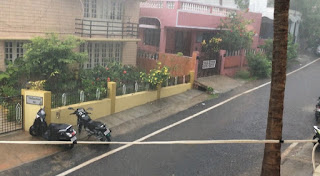“Tomorrow, don’t do headstands,” I hear from my teacher across the room just this last Wednesday. I can barely process information at this point, having just sweat what seems like my total body weight as I finish the last postures of intermediate, 7 headstand variants each with their swift air-cutting transition to chatvari, chaturanga dandāsana—these are the last postures he gave me nearly two years ago. I nod, though, I don’t think I understand exactly what he is saying and wonder who in the room I might be able to harass for verification later. I also wonder how he does it, that distressing mind reading thing he seems to do so very well. Just minutes before getting on with the headstands I had sighed silently to myself and wished I that didn’t have to do them anymore.
But...was there more? It seemed like he had said more, but whatever passed through his lips was slightly muffled under the bit of cloth he’d pulled over half his face as he started dropping a student back—I’m getting used to this back-bending-bandit look of his, and I’m glad he is taking better care of himself in there, but it’s definitely hard to distinguish words through it. Luckily, a friend was much more aware of his instructions and filled me in on what I had missed: aside from omitting headstands I was to do vishvamitrāsana, the first posture of Advanced A, series 3 out of 6 in the āsana portion of the ashtanga method. In a way, it’s no big deal, it’s just another posture in another series of poses. I had a brief moment with the first few postures of Third with a senior teacher, but it didn’t feel right at the time, it was so intense, both my body and my mind had serious doubts about moving forward. I felt strongly that when it was really time for me to move forward, the go ahead would come from my teacher.
So, when I finally had a moment with myself and this bit of news, I turned on my iPad thinking that I might start to write about it—instead, tears came streaming down. I wish I were cooler, more unaffected, but the truth is it is kind of a big deal for me and I’m excited and scared for the new challenges that lie ahead. More so, new postures, when they come, are like landmarks on a long and beautiful path. They help gauge where we are, what are needs are, and what lessons are for us. They help us anchor into the practice, they keep us engaged and keep us from getting distracted. A new series is a whole new chapter, maybe a whole new book, a new way of being in the body, breath, and mind.
What struck me, as I was cleaning out my tear ducts, is the sheer magnitude of the yoga journey, it is so vast and all-encompassing that I often don’t even realise that I am on it. And then a moment like this comes and it’s almost staggering to see the bigger picture.
I started this practice when I was thirty (I just turned 42), with no previous inclination towards exercise or physical activity. I was fairly uncoordinated and couldn’t even come close to touching my toes. This October will by my eighth year of going to Mysore, it’s my seventh trip, over which I think I’ve spent a year and a half in total studying at the shala. This alone is just fantastic—as in made of fantasy! Like how did this even happen? What weird turn did I make to end up in this alternative universe? It’s been eight years of piecing together Intermediate Series with Sharathji, over which time my body has opened, closed, stalled, gotten more flexible, gotten stronger, become less flexible, etc...
Everything is relative, of course, I know students who have spent much more time or much less time here; time here and āsana practice is not always an accurate gauge for study and self-transformation. I think everyone has their own pace and learns whatever lessons are meant for them.
The challenges that I have faced, however, in the physical practice have closely mirrored the struggles in my own life. I have totally disintegrated here, I have been ambitious and distracted, I have been lost and uncertain. I have also learned what it means to be a student and how important it is to have a teacher. I’ve learned how to be more patient and forgiving towards myself. I’ve learned to have more fun. And over the recent years, I have also been more stable, joyful, more self-loving, and more accepting of myself and, thus, of those around me.
Little has changed, really. Starting Advanced A doesn’t come with enlightenment. I’m still huffing and puffing through my intermediate postures. I kind of feel like I won the lottery, I get a new pose and it’s not terrifying or overly difficult AND I get to drop 7 intense headstands. It’s a great deal. Other than that, it’s the same, the same determination, same devotion to practice, the same discipline.
But, still, I’m kind of stupefied. It’s been such a journey—and there is more, always more with the ashtanga practice. There are more postures, yes, but that’s just the tip of the iceberg. There are more challenges, more struggles, more fun, more terror, more growth, more transformation, more to learn and definitely more to love!

